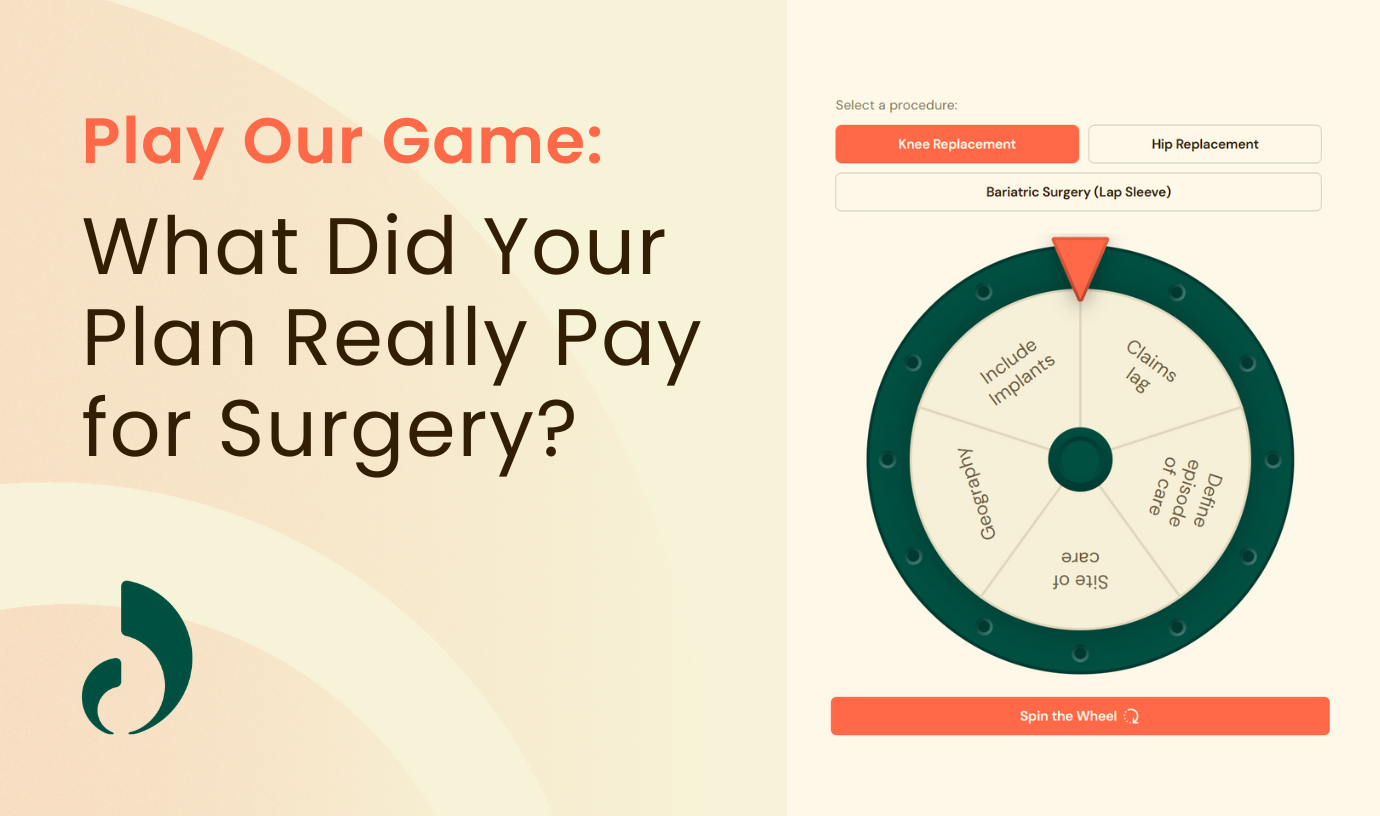Benefits leaders choose Centers of Excellence (COEs) for their employees to connect them with excellent care and, ideally, reduce costs for expensive procedures like orthopedic surgery. However, most traditional COE approaches don’t deliver hard-dollar savings to employers. And even when they do, getting employees to use COE programs traditionally has been challenging.
One “secret” to finding a COE employees want to use? Make care as affordable as possible for them, too. In a recent webinar, we discussed how modern employers are driving utilization of their COEs and significantly lowering costs at the same time.
In this webinar, you’ll hear from:
Erin Tatar, SVP, Consulting Relations, Lantern
Raymond Hwang, MD, VP, Medical Director, Lantern
Dawn Beaudin, Vice President, Benefits, Hyatt
Read on to learn about:
- How to find a COE that reduces costs through both better outcomes and lower negotiated rates
- How Hyatt’s plan design drives utilization
- The savings and results Hyatt has seen since launching Lantern
Specialty Care Costs are on the Rise
Specialty care like cancer, orthopedic care and high-cost therapies continue to be some of the top drivers of healthcare costs. Dr. Hwang says there’s a tremendous variation in cost for specialty care across the country and even in individual cities—and that these high costs aren’t related to higher quality. “Within the Dallas/Fort Worth area, there can be a 9X difference in cost of the same arthroscopy surgery,” he said. “And there are potentially quite a few surgeries being performed that may not be necessary.”
Other than looking at high drivers of cost, like cancer and diabetes, Dawn Beaudin, VP of Benefits at Hyatt Hotels, admits that specialty care wasn’t something Hyatt looked at closely until a few years ago. “In 2021, we decided to look a little deeper and found we were spending a lot on surgical care,” Beaudin said. “And that was when we started down the path of exploring surgical Centers of Excellence, which led us to Lantern.”
How to Lower Specialty Care Costs with an Independent COE
When choosing a COE that lowers costs, employers have a few levers to pull. The first focuses on quality.
During the webinar, Dr. Hwang and Tatar discussed the importance of making sure your employees are going to the best surgeons who specialize in specific procedures and deliver low complication rates. More successful surgeries mean fewer readmissions, which lowers costs, too.
That’s where Lantern’s Network of Excellence comes into play, which includes vetting providers carefully on an individual level. “This is a multi-step process that rigorously evaluates the provider, not just their training and expertise, but their practice patterns, the volume of procedures, what procedures are performed the most, as well as an in-depth view into their protocols around their surgeries,” Dr. Hwang said.
For example, he said surgeons must thoroughly evaluate a patient prior to a procedure, especially for orthopedic or bariatric surgery, making sure to address needs such as behavioral health counseling, weight loss, and smoking cessation. “These have meaningful impact on outcomes … giving patients the best chance for success,” said Dr. Hwang, adding Lantern’s network providers have less than a 1% complication rate because of the rigorous vetting processes.
Most importantly in terms of savings, your COE should deliver unit cost reductions compared with what you’re paying through your health plan or carrier. Find a solution that’s leveraging prospective bundles and lower negotiated rates for a range of procedures. “You’re primarily going to get this through an independent COE because most of the time, the carrier or health plan COEs are leveraging rates that are close to or the same as what you’d pay under your standard PPO contract,” Tatar said.
When Hyatt chose Lantern as its independent COE, Beaudin said they had greater insight into what they were paying for surgeries compared to what they could see through a traditional carrier model. “We liked the fact that Lantern was steering procedures to ambulatory surgical centers, which was ultimately reducing that unit cost because we were using a lower cost facility and removing some of those high-cost hospital fees,” she said.
“We wanted a strong local network. We wanted to ensure that we had a good balance between quality and accessibility. Over 80% of our colleagues are within driving distance of a Lantern affiliated surgeon.”
How Hyatt Has Seen Success with Lantern’s Specialty Care Platform
Through its partnership with Lantern’s independent COE, Hyatt has continued to see results since 2022, including a cumulative savings of $16.1 million and a lifetime average savings of $29.90 PEPM.
“We saw a unit cost savings across the board for mandatory procedures, but definitely smaller dollar savings with other surgical procedures as well,” Beaudin said. “People are taking advantage of Lantern.”
Thanks to its success with Lantern’s surgery program, Hyatt has since decided to launch the cancer and infusion programs. The cancer program provides employees with access to oncology nurses who help navigate the complexities of diagnosis and treatment, along with expedited access to National Cancer Centers around the country.
“We really wanted to do something to ensure our colleagues and their families who have cancer have access to the best oncologists and specialists to return to good health,” Beaudin said. “[They’re] getting the support they need to help them through a difficult time.”
Hyatt added Lantern’s infusion program this year to save on the high cost of the medications at hospitals and give employees access to infusions at independent community centers or from home. “We can take some of that cost out, but also give a better member experience, so that was easy for us to pull the trigger,” Beaudin said.
Overall, she says it feels good knowing that Hyatt is giving its employees access to high-quality, affordable healthcare close to home: “We were really excited to find a solution that met all of our requirements.”

Creating a Specialty Care Program Employees Will Use
Beaudin said providing employees with high-quality, affordable specialty care was crucial, but they also had to make sure employees were actually using it. Some traditional COE models typically include a small number of contracted facilities, requiring employees to travel. Distance to care is a significant barrier because most people don’t want to travel for a procedure. Health plan COEs may have more locations, but because of steerage limitations, member awareness and utilization tends to be low. Independent COEs, however, have the ability to steer directly to individually selected, high-quality surgeons and specialists wherever they operate.
“We wanted a strong local network,” Beaudin said. “We wanted to ensure that we had a good balance between quality and accessibility. Over 80% of our colleagues are within driving distance of a Lantern affiliated surgeon.”
To increase engagement and utilization, Hyatt carefully considered their plan design. “We knew the traditional approach to introducing a new program and sending out communications wasn’t going to be enough,” Beaudin said. “We needed to do some steerage.”
Hyatt waived deductibles so there was no cost to Hyatt colleagues if they chose to use a provider through Lantern. “That was a huge incentive,” Beaudin said. “We have people that come to us that say, ‘I couldn’t afford the surgery, but I got it for free.”
Hyatt also required employees who needed bariatric, spine and joint surgeries to use Lantern. Beaudin admits it wasn’t always easy telling employees they had to use a Lantern provider. Helping employees get access to high-quality surgeons and save money has been worth it, however, and employes now really like the benefit—giving Lantern a 9.3 rating out of 10. “We’ve won everybody over. Once they go to a Lantern surgeon and have the experience, the feedback comes back really positive,” Beaudin said.
Employers must also communicate the value of a COE. Tatar reminded the audience of the marketing best practice that people need to see something up to seven times to really absorb it. Hyatt has leveraged a flyer and postcard series from Lantern and worked with its internal communications teams on emails and digital messaging.
Last year, Hyatt worked with Lantern on targeted commutations based on claims data for people who might need surgery. “Even though we just started, we believe it’s having an impact already,” Beaudin said.




